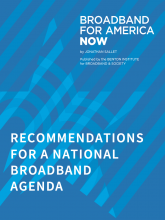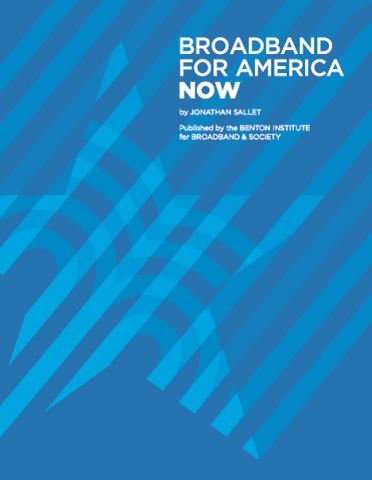See Benton's Recommendations for a National Broadband Agenda and recognition of the many contributions that informed our thinking.
For more in-depth discussions about the nation's broadband challenges and proposed solutions, see our reports:
Broadband for America Now | Broadband for America’s Future: A Vision for the 2020s
If We Build It, Will They Come? Lessons from Open-Access, Middle-Mile Networks
We need a national, comprehensive broadband strategy, a plan that ensures that everyone in America can use High-Performance Broadband as soon as possible. High-Performance Broadband available to everyone in America is an important ingredient for a more just America, a healthier society, and an economy that offers true opportunity for everyone. We need to inject a new sense of urgency into implementing equitable broadband policies.
Before he passed, Congressman John Lewis told us, “Access to the Internet … is the civil rights issue of the 21st century.” There are almost three times as many people without broadband in urban/metro places than in rural places, and lack of broadband adoption is greater among Black, Hispanic, and lower-income households. Federal Communications Commissioner Geoffrey Starks, joined by civil rights leaders, explained, “Our historic failure to close the digital divide has had a devastating effect on communities of color in both rural and urban America.”
Five overarching principles should guide a comprehensive broadband strategy:
- Digital Equity: Making affordable High-Performance Broadband available to low-income, unserved, and underserved populations—accompanied by training in digital skills that empowers users to make the most of their connections—will contribute to a more equitable society.
- Deployment: In a world in which the talents of all people matter, broadband infrastructure investment is a necessary economic strategy. There is no reason to saddle any area with second-rate broadband.
- Competition: Americans should not have to pay more merely because public policy has failed to promote competition effectively.
- Community Anchor Institutions: Using broadband to fulfill their missions, these institutions should be able to reach users wherever they are and serve as launching pads for communitywide access.
- State and Local Leadership: The best approach is to fuse federal support with more trusted state, tribal, and local leadership to ensure the promise of universal, affordable, open broadband.
Join the Conversation
The latest conversations about a national broadband strategy
Get Updates
On Democracy, Unity, & Broadband

On January 20, I heard a celebration of democracy – and a call that, in the midst of the pandemic, economic disparity, racial inequity, and a climate in crisis, “unity is our path forward.” In our American democracy, we are called upon to inform ourselves, form our own opinions, and contribute to the debate so we can decide together what is best for our communities and our nation. The call for unity requires us to accept that there are differences, to reach the end of a debate, and to accept the decisions made in our democratic process. E pluribus unum. Although we have many voices, we remain one. Without that commitment to each other, our democracy dies, our nation fails.
At the Benton Institute, we are not for broadband for broadband’s stake. We see it as the infrastructure of opportunity—an essential tool to ensure a thriving democracy.
Recommendations for a National Broadband Agenda

We need a national, comprehensive broadband strategy, a plan that ensures that everyone in American can use High-Performance Broadband as soon as possible. These recommendations are drawn from Benton's Broadband for America Now and Broadband for America’s Future: A Vision for the 2020s. They highlight actions that can be taken by the Biden Administration, Congress, and the Federal Communications Commission.
Contributions to a National Broadband Agenda

The Benton Institute for Broadband & Society’s work on a national broadband agenda is built on the lessons and innovative ideas of communities, public-interest advocates, government officials, and industry experts that have labored to expand broadband’s reach to everyone in the United States. We’ve compiled a list of their research reports and briefs that contribute to the ongoing discussion of broadband policy crafted in the public’s interest.
If We Build It, Will They Come? Lessons from Open-Access, Middle-Mile Networks

This policy brief, written by Jordan Arnold and Jonathan Sallet, explains why and how the federal government should support the construction of open-access, middle-mile networks and how that support can be structured. It provides background on different kinds of open-access, middle-mile networks across the nation. It proposes the structure for a federal open-access, middle-mile grant program, incorporating the lessons we have learned about what boosts the chance for open-access, middle-mile success. And it focuses on the reasons the construction of open-access, middle-mile networks furthers deployment and competition.
America Needs Broadband Now

The strength of High-Performance Broadband is that it will—if fully accessible to all in America—help solve some of our most critical challenges and help people overcome key barriers regardless of where they live and who they are.
Last year we asked you to imagine each community enabled to identify and build on its strengths and employ technology accordingly.
This year we say we can’t wait any longer to make it happen. We must start addressing at-home internet access as a civil rights emergency in need of a comprehensive solution. We ask for Broadband for America Now since our current crises demand it.


